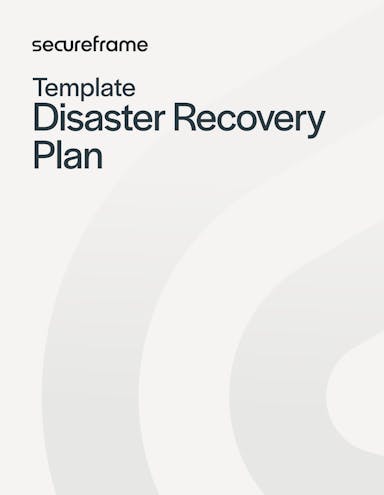
Disaster Recovery Plan Template, Examples & Why You Need One for 2026
Anna Fitzgerald
Senior Content Marketing Manager
Cavan Leung
Senior Compliance Manager
According to the 2025 Global Assessment Report on Disaster Risk Reduction, the global cost of disasters has grown significantly in the past decades, now exceeding $2.3 trillion annually.
Part of this ballooning cost is the financial losses caused by company downtime that results from a disaster. In a 2025 survey conducted by Cockroach Labs, 100% of surveyed technology executives worldwide said their companies lost revenue due to outages in the previous year. On average, they experienced 86 outages with losses ranging from at least $10,000 to over $1,000,000 per outage.
With disasters becoming more frequent and costly, having a documented disaster recovery plan is key to improving operational resilience so your organization can recover any lost data or capability as quickly as possible to minimize the cost of downtime when a disaster occurs.
Below we provide the definition of a disaster recovery plan, a step-by-step guide to writing one, and examples and a template to help ensure you get this essential plan in place—before it’s too late.
What is a disaster recovery plan?
A disaster recovery plan (DRP) is a contingency planning document that outlines the instructions or procedures an organization will follow to recover and restore its critical systems, operations, and data to normal or new-normal conditions after a disaster.
A disaster is a sudden event that disrupts the continuity of product or service delivery or any mission essential functions over a period of hours or days. Common examples of disaster events are:
- Cyber attacks
- Natural disasters
- Power outages
- Hardware and system failures
- Human errors
When any of these events occurs, a disaster recovery team typically assesses the severity of the event to determine whether the recovery plan should be activated. If it is a disaster event, then the team follows the predefined steps in the DRP to restore operations.
Before we take a closer look at the purpose of a DRP, let’s differentiate between two key contingency planning documents that are often confused.
Recommended reading

20 Recent Cyber Attacks & What They Tell Us About the Future of Cybersecurity
Disaster recovery plan vs business continuity plan
A disaster recovery plan and business continuity plan both take a proactive approach to minimize the impact of a disaster before it occurs and may even be combined into a single document as a result.
However, the key difference is that a disaster recovery plan focuses on limiting abnormal or inefficient system function by restoring it as quickly as possible after a disaster, whereas a business continuity plan focuses on limiting operational downtime by maintaining operations during a disaster.
In other words, a disaster recovery strategy helps to ensure an organization returns to full functionality after a disaster occurs. A business continuity plan helps an organization keep operating at some capacity during a disaster. That’s why organizations need to have both documents in place, or need to incorporate disaster recovery strategies as part of their overall business continuity plan. Here's a template that includes both.
Purpose of a disaster recovery plan
Ultimately, the purpose of disaster recovery planning is to minimize the impact of a disaster and ensure business continuity. A well-designed disaster recovery plan can help by accomplishing the following four core objectives:
1. Minimize downtime and recovery costs
A DRP provides structured, repeatable steps to restore systems and services quickly, reducing the financial and operational impact of outages. This is increasingly important as disaster events become more common and recovery remains expensive, particularly for critical infrastructure industries like healthcare.
According to IBM’s Cost of a Data Breach Report 2025, recovery processes are improving but the costs associated with one of the most common disaster scenarios—a data breach—are declining but still significant, with organizations losing $1.38 million on average in lost business, an additional $1.2 million in post-breach response efforts, and nearly $390,000 in notification costs alone.
A robust DRP helps organizations recover faster, avoid prolonged disruptions, and limit the cascading financial and reputational damage that often accompanies extended downtime.
2. Prevent data loss
A disaster recovery plan documents backup strategies, data replication schedules, failover processes, and recovery procedures that ensure essential data can be restored accurately after a disaster. This is vital as data recoverability continues to decline.
According to the Veeam 2025 Ransomware Trends and Proactive Strategies Report, only 10% of ransomware victims recovered more than 90% of their data, while a majority (57%) recovered less than half.
A DRP dramatically improves your organization’s odds of avoiding catastrophic data loss.
3. Provide peace of mind for employees and external stakeholders
A comprehensive DRP reduces stress, confusion, and decision paralysis when systems fail. Clear roles and responsibilities ensure teams know exactly what to do, which can help improve morale and job security. In fact, 82% of leaders surveyed in The State of Resilience 2025 said their teams fear technical staff could be fired for unplanned downtime or outages due to disasters.
A documented DRP can provide increased assurance not only to employees but also to vendors, customers, partners, and board members.
4. Avoid regulatory fines and compliance risk
Many cybersecurity and risk management frameworks—including HIPAA, DORA, NIS2, PCI DSS, SOC 2, ISO 27001, CMMC, FedRAMP, GovRAMP, TX-RAMP, NIST RMF, and GDPR—have explicit requirements or requirements that can be met by having disaster recovery processes in place and formalized in a DRP (or similar plan like a Contingency Plan) .
Without a DRP, organizations face increased breach costs, audit failures, and potentially significant regulatory penalties. Nearly half (44%) of technology executives say they are losing sleep over fines tied to downtime and outages, and this concern spikes to 85% among leaders in EMEA.
A disaster recovery plan is therefore not only a resilience tool, but a regulatory and financial safeguard.
Recommended reading

Non-Compliance Fines and Sanctions: Real Cases With $ Impact + Enforcement Trends to Watch in 2026
When is the disaster recovery plan invoked?
A disaster recovery plan (DRP) is invoked when an event severely impacts an organization's ability to function for an extended period of time. Disaster events include:
Cyber attacks
Distributed denial-of-service (DDoS), ransomware, social engineering, and other types of cyber attacks can compromise sensitive data, disrupt services, and result in system downtime. In response, organizations may need to isolate affected systems, restore backups, and reinforce security measures.
Example: The 2023 ransomware attack on MGM caused a nine-day outage across hotel, gaming, and reservation systems and resulted in over $100 million in losses in Q3 of that year alone.
Natural disasters
Earthquakes, floods, hurricanes, or fires can physically damage data centers, offices, and communication networks, preventing normal business operations. Recovery may involve relocating to alternative sites, restoring backups, and ensuring employee safety.
Example: In 2024, Hurricane Milton flooded hundreds of thousands of buildings, left millions without power, and caused widespread network outages across Florida. It was ranked as the most expensive single climate disaster event, causing $60 billion in damages and killing 25.
Power outages
Extended power failures can disrupt servers, networking equipment, and cloud services, leading to downtime and potential data corruption. To recover from an outage, an organization may need to deploy backup generators, use uninterruptible power supplies (UPS), and ensure failover data centers are available.
Example: In April 2025, a power outage affected tens of millions of people across almost all of Spain and Portugal and led to major disruptions to transport services, payment processing, and sporting events.
Hardware and system failures
Critical server crashes, storage failures, or database corruption can interrupt applications and prevent users from accessing critical services. Recovery typically involves hardware replacement, system restoration from backups, or redundancy measures to prevent recurrence.
Example: The 2024 CrowdStrike flawed update which caused a global IT outage that resulted in flight delays, hospital closures, and an estimated financial loss of $5.4 billion for the Fortune 500. It is considered the biggest global software failure to date.
Human errors
Accidental data deletion, misconfigurations, or insider threats can lead to operational failures and security breaches. In response, an organization may need to restore data from backups, implement stricter access controls, and provide employee training to prevent future incidents.
Example: In October 2025, a DNS error in AWS’s Northern Virginia region disrupted more than 100 AWS services and temporarily brought down major platforms like Reddit, Snapchat, and Venmo.
Recommended reading

Supply Chain Attacks: Recent Examples, Trends & How to Prevent Them in 2026
Disaster recovery plan elements in a sample DRP
Just as no two businesses are the same, no two disaster recovery plans are. However, they do typically include some common elements. These elements are detailed below, with sample sections from NWF Health’s Information Technology Disaster Recovery Plan to show a potential format and wording for each element.
Data backup and recovery
A section of a DRP should be dedicated to data backup and recovery. This should list backup methods, frequency of backups, the storage locations, and the procedures for data restoration.
For example, NWF Health’s DRP includes a “Server Recovery Plan” section that details backup schedules, responsibilities of their third-party support vendor DIS as well as internal folks, and restoration steps.

Redundant systems and infrastructure
Another section may explain how the organization implements redundant systems and infrastructure to ensure high availability and minimize downtime if a disaster occurs. This may involve duplicating critical servers, network equipment, power supplies, and storage devices using clustering, load balancing, failover mechanisms, virtualization technologies, or other measures.
In NWF Health’s sample, hardware redundancy is addressed through documented hardware replacement and notification procedures, for example.

Alternate worksite
A DRP may identify alternative worksites or recovery locations where the organization can operate if the primary site becomes inaccessible. This section should also define procedures and infrastructure needed to quickly transition operations to the identified alternate sites.
NWF Health includes a “Facility Plan” section that details the requirements for a functional alternate facility.

Communication and notification
Another part of DRP may define communication protocols and notification procedures to ensure communication during and after a disaster. Protocols and procedures typically include:
- notifying employees, customers, vendors, and stakeholders about the disaster
- providing updates on recovery progress
- maintaining contact information for key personnel and emergency services
NWF Health’s DRP includes a section on expected communications during emergency maintenance, for example.

Recovery objectives
A DRP may set acceptable time frames for recovering systems and data in terms of recovery time objectives (RTO) and recovery point objectives (RPO). These objectives should be based on the criticality of systems and shape recovery strategies accordingly.
- RTO: The maximum amount of downtime allowed
- RPO: The maximum loss of data accepted (measured in time)
NWF Health’s plan includes a table that lists the RTO and RPO of every major IT service or application that may be affected by a disaster, including the data centre facility, storage services,

Disaster recovery plan template
Creating a disaster recovery plan from scratch can be overwhelming, especially because a complete DRP must include many interdependent components, as discussed above.
Using a template with foundational sections helps simplify the process and ensure:
- You don’t miss critical elements such as alternate facilities, escalation protocols, or dependency mapping.
- You write clearer, more complete documentation because each section includes prompts for what information to include.
- You can build a DRP faster especially for teams that have never documented disaster recovery procedures before.
- Your plan stays consistent with standardized language, formatting, and structure across departments or business units.
Use this template to kick off your disaster recovery planning and customize it based on your organization's unique risk appetite, recovery strategies, and operational priorities.

Free disaster recovery plan template
Use this template to kick off your disaster recovery planning and customize it based on your organization's specific risks and objectives.
Types of disaster recovery plans
A disaster recovery plan can be tailored to a specific system, environment, type of disruption, or security framework. While all DRPs share the same goal—restoring critical operations after a disaster—the structure and recovery procedures differ depending on what needs to be recovered and how quickly.
Below are the most common types of disaster recovery plans and what each one focuses on.
IT disaster recovery plan
An IT disaster recovery plan focuses on restoring an organization’s technology environment, including applications, servers, operating systems, and databases. It outlines the technical steps required to recover mission-critical IT services, identify system dependencies, and return applications to normal performance levels.
This type of plan is essential for organizations whose operations rely heavily on digital systems or SaaS applications.
Data center disaster recovery plan
A data center DRP provides detailed procedures for recovering physical and virtual infrastructure housed in an on-premises or co-located data center. It typically includes steps for equipment replacement, facility access, environmental controls, hardware configurations, and powering up systems in an alternate location.
This plan is most relevant for organizations operating their own data centers or hybrid environments.
Backup disaster recovery plan
A backup DRP is centered on ensuring that critical data can be recovered quickly and accurately after loss or corruption. It covers backup retention schedules, storage locations, restoration tools, verification procedures, and chain-of-custody requirements for sensitive or regulated data.
This type of plan is essential as data loss remains one of the most costly and common outcomes of cyber attacks, hardware failures, and human error.
Network disaster recovery plan
A network disaster recovery plan outlines how to restore connectivity across the organization’s network infrastructure, including routers, switches, firewalls, VPNs, and cloud networking components. The plan identifies critical communication paths, acceptable failover configurations, and procedures for re-establishing internal and external access.
Because network outages can halt all business operations, this plan is crucial for minimizing downtime.
Cloud disaster recovery plan
A cloud DRP focuses on restoring systems, data, and services hosted in cloud environments such as AWS, Google Cloud, Azure, or a private cloud. It includes strategies such as replication across regions, failover orchestration, DRaaS (disaster recovery as a service), and cloud-native backup tools.
As organizations move more workloads to the cloud, cloud-specific DRPs help ensure redundancy, availability, and rapid recovery.
NIST disaster recovery plan
A NIST disaster recovery plan may be based on the guidance provided in NIST SP 800-34 Revision 1, which identifies the DRP as one of eight types of information system contingency plans. NIST defines a DRP as “an information system-focused plan designed to restore operability of the target system, application, or computer facility infrastructure at an alternate site after an emergency.”
This type of plan is especially relevant for federal agencies and contractors that may experience a major disruption usually causing physical damage to the original data center and requiring relocation to restore information systems.
Ransomware disaster recovery plan
A ransomware DRP outlines the actions needed to detect, contain, eradicate, and recover from a ransomware attack. It includes procedures for isolating infected systems, identifying clean backups, restoring encrypted data, communicating with internal and external stakeholders, and preserving forensic evidence.
This type has become increasingly important as ransomware remains one of the most prevalent cybersecurity threats and damaging disaster events.
Recommended reading

Ransomware Attacks: Definition, 10 Famous Examples & Tips to Prevent Them
Disaster recovery plan examples
Below you can find examples of disaster recovery strategies and procedures from disaster recovery plans created and maintained by universities and other organizations. This should help you in brainstorming and documenting your own recovery strategies and plans for different services, environments, and types of disasters.
1. Southern Oregon University
Type: IT disaster recovery plan
Southern Oregon University maintains a comprehensive IT DRP because its faculty, staff, and students rely heavily on technology services. The plan covers a wide range of IT assets including the university’s data center, network infrastructure, enterprise applications, desktop hardware, client systems, classrooms, and labs.
Some of the IT disaster recovery processes and procedures outlined in the plan are:
- Secure facility as necessary to prevent personnel injury and further damage to IT systems.
- Coordinate hardware and software replacement with vendors
- Verify operational ability of all equipment on-site in the affected area (servers, network equipment, ancillary equipment, etc.). If equipment is not operational, initiate actions to repair or replace as needed.
- If the data center is not operational or recoverable, contact personnel responsible for the alternate data center and take necessary steps to ready the facility.
- Retrieve most recent on-site or off-site back-up media for previous three back-ups. Prepare back-up media for transfer to primary or secondary datacenter, as determined during the initial assessment.
This example provides a strong model for organizations that need to document detailed IT recovery procedures across complex on-premises environments and diverse user groups.
2. AllCode’s AWS disaster recovery plan
Type: Cloud disaster recovery plan
AllCode, a cloud development and DevOps consulting firm, operates primarily on AWS and maintains a disaster recovery plan tailored specifically for cloud-based environments. Their plan provides a strong example of how organizations can leverage AWS-native tools and architectures to achieve resilience, reduce downtime, and enable rapid failover.
Key components of AllCode’s AWS disaster recovery plan include:
- Multi-Region redundancy: Workloads and data are replicated across multiple AWS Regions and Availability Zones to ensure systems can fail over if the primary region becomes unavailable.
- Automated infrastructure provisioning: Using AWS CloudFormation and Terraform, AllCode can rebuild infrastructure quickly and consistently in a recovery Region.
- Automated backups: AWS Backup, EBS snapshots, and RDS automated backups ensure data is captured at regular intervals and stored in multiple locations for resilience.
- Pilot light environments: Critical core services run continuously at low capacity in a secondary Region, allowing the organization to scale up rapidly if the primary Region fails.
- Failover routing: Amazon Route 53 is configured with health checks and DNS failover to redirect traffic to the recovery environment during disasters.
- DR testing and validation: The team performs routine failover tests using isolated test accounts and Regions to verify that infrastructure, data, and applications can be restored within the required RTO and RPO targets.
This example provides a useful blueprint for organizations running workloads in AWS or any major cloud platform.
3. University of Iowa
Type: Data center disaster recovery plan
The University of Iowa maintains a detailed data center DRP covering the steps required to recover or relocate operations if its primary data center is impacted by a natural disaster, equipment failure, or other major disruption.
Examples of the data center recovery procedures include:
- Have large tarps or plastic sheeting available in the data center ready to cover sensitive electronic equipment in case the building is damaged due to natural disasters like tornadoes, floods, and earthquakes.
- If replacement equipment is required, make every attempt to replicate the current system configuration.
- If data is lost, then request that the IT department recover it from an off-site backup or cloud deep archive storage.
This example serves as a practical reference for any organization that operates its own data center and must plan for physical infrastructure damage, environmental risks, and hardware-specific recovery steps.
How to create a disaster recovery plan
Writing and maintaining a disaster recovery plan requires collaboration and coordination among key stakeholders across an organization and can seem intimidating. Below we’ll outline the process step by step to help you get started.

1. Define the plan’s objectives and scope
To start, define the objectives and scope of your disaster recovery plan.
Objectives may include:
- safeguarding employees’ lives and company assets
- making a financial and operational assessment
- securing data
- quickly recovering operations
Next, identify what and who the plan applies. Typically, assets utilized by employees and contractors acting on behalf of the company or accessing its applications, infrastructure, systems, or data fall within the scope of the disaster recovery plan. In this case, employees and contractors are required to review and accept the plan during onboarding and regularly after that.
2. Perform a risk assessment
Identify potential risks and vulnerabilities that could lead to a disaster, both internal and external to the organization. This should involve evaluating your reliance on external vendors and suppliers for critical services or resources and assessing their own disaster recovery capabilities to ensure they align with your organization's requirements.
3. Perform a business impact analysis
Next, determine the business functions, processes, systems, and data that are essential for your organization's operations. For each critical component, establish recovery time objectives and recovery point objectives.
4. Define recovery measures and procedures
Define the appropriate measures and step-by-step procedures for disaster recovery based on the risks and business impact you identified. This includes identifying the individuals or teams responsible for recovery tasks, the resources required, and the order of recovery tasks.
As stated above, these recovery tasks may fall into the following categories:
- Data backup and recovery
- Redundant systems and infrastructure
- Alternative worksite
- Communication and notification
You may also want to outline emergency procedures. These are the actions that should be taken during and immediately after a disaster occurs, and may include evacuation plans and communication protocols and coordination with emergency services.
5. Conduct training so teams understand their roles
Recovery is only as effective as the people executing the plan. Provide ongoing training so employees understand their responsibilities during a disaster. Conduct workshops, role-based drills, or internal walk-throughs to ensure staff can perform the tasks assigned to them in the DRP.
6. Review and update the plan regularly
Review and update the disaster recovery plan periodically to incorporate changes in technology, business operations, potential risks, and regulatory requirements. Ensure that contact information, system configurations, and other relevant details are up to date.
Recommended reading

A Guide to Regulatory Change Management & How Software Can Simplify It
How to test and validate disaster recovery plan
Testing your disaster recovery plan is essential to ensure it works as expected when a real disruption occurs. A well-designed testing cycle helps validate your recovery procedures, uncover gaps, and confirm that your RTO and RPO targets can be met.
Here are the most common methods for testing a DRP:
- Tabletop exercises: Team members walk through simulated disaster scenarios in a conference-room setting to validate roles, decision points, communication flows, and recovery steps.
- Backup restoration tests: Verify that backups can be restored fully, accurately, and within the required recovery time. This includes testing off-site, cloud, and immutable backups.
- Technical recovery drills: Rehearse specific recovery actions such as failover, system rebuilds, environment provisioning, and application restarts.
- Full failover simulations: Switch operations to your secondary data center or cloud region to ensure all systems, networks, and dependencies work end-to-end in the recovery environment.
- Cloud resilience tests: Perform region-failover tests, automated provisioning checks, and health-check validations (AWS Route 53, Google Cloud Observability, Azure Traffic Manager).
- After-action reviews: Document lessons learned, update recovery procedures, assign remediation tasks, and incorporate improvements into the next DRP version.
Regular testing—at least annually and after major technology changes—ensures your plan remains accurate, actionable, and effective.
Recommended reading

How to Run Effective Cybersecurity Tabletop Exercises + 6 Scenario Templates
Disaster recovery plan best practices
While every organization’s disaster recovery plan will look different depending on its systems, data, and regulatory landscape, several best practices consistently appear across authoritative guidance from HHS, Google Cloud, AWS, and NIST.
Incorporating these practices can significantly strengthen your organization’s resilience and reduce recovery time after a disaster.
1. Align with framework and regulatory requirements
If your organization must comply with a regulatory or cybersecurity framework, ensure your DRP meets all applicable requirements.
For example, HIPAA’s Disaster Recovery Plan specification (§164.308(a)(7)(ii)(B)) requires covered entities to establish procedures to restore any loss of electronic protected health information (ePHI). HHS explains that a general disaster plan may meet this requirement, but entities must ensure that it allows them to recover ePHI specifically—or update language and procedures accordingly.
A framework-aligned DRP not only strengthens resilience but reduces compliance risk, violations and fines, and audit exceptions.
2. Make all tasks specific and actionable
Ambiguous steps slow down recovery and increase the risk of errors during high-pressure incidents.
Instead of vague instructions like “Run the restore script,” Google Cloud recommends defining exact commands, file paths, tools, and responsible roles like “Open a shell and run /home/example/restore.sh.”
Clear instructions like this ensure consistent execution and reduce human error.
3. Maintain accurate asset inventories and dependencies
NIST SP 800-184 recommends maintaining a current list of all people, processes, technology assets, and data required to resume mission/business processes as quickly as possible. Documenting these resources is essential to realistic recovery efforts, ensuring priority levels are set and recovery activities are sequenced and completed in a timely manner.
4. Select an appropriate cloud recovery strategy
AWS outlines four primary cloud disaster recovery strategies. It’s essential that you understand, select, and regularly test the option that enables you to meet your RTO and RPO requirements without overspending.
- Backup and restore: Lowest cost, longest recovery time
- Pilot light: Minimal core infrastructure kept running for faster scale-up
- Warm standby: A scaled-down production environment running continuously
- Multi-site active/active: Near-zero recovery time, highest cost
How Secureframe can help your disaster recovery planning efforts
Secureframe’s compliance automation platform and expert guidance help organizations build, maintain, and continuously validate a disaster recovery plan that meets modern regulatory requirements and withstands real-world operational disruptions.
Beyond simplifying documentation, Secureframe provides the automation, monitoring, and expertise needed to proactively reduce risk and recover quickly when disaster strikes.
Key features of our compliance management system include:
- Automated control testing for DR requirements: Secureframe automatically tests disaster recovery–related controls across 50+ frameworks through integrations with your existing tech stack. This ensures continuous compliance without the manual burden of tracking and validating recovery requirements.
- Policy templates developed by compliance experts: Secureframe provides auditor-vetted policies and procedures, including disaster recovery and business continuity templates, to eliminate the guesswork of documentation. You can publish policies, assign owners, track acceptance, and manage periodic reviews all within the platform.
- Compliance expertise from former auditors: Secureframe’s in-house compliance experts and former security and compliance auditors offer guidance at every stage—from initial plan development to testing, updating, and aligning with framework requirements—ensuring your DRP reflects best practices and enhances cyber resilience.
- Continuous monitoring: Secureframe enables ongoing adherence to regulatory and cybersecurity requirements by automatically monitoring controls, scheduling regular reviews, and surfacing issues before they escalate into disruptions.
- AI-powered risk assessment: Comply AI automatically identifies, scores, and recommends treatment for risks—including those tied to disaster recovery—while generating justifications, residual risk, and documentation instantly.
- Integrated risk management: Secureframe’s risk library includes NIST-aligned risk scenarios across IT, fraud, legal, privacy, and finance, making it easy to add, categorize, and track risks. You can then link risks to controls, track history, and align risk treatment plans with compliance requirements to strengthen your organization’s overall security posture.
Together, these capabilities help organizations prevent disasters where possible, minimize their impact when they occur, and maintain operational resilience year-round.
Request a demo to learn how Secureframe can help strengthen your disaster recovery and resilience strategy.
This post was originally published in July 2023 and has been updated for comprehensiveness.
FAQs
What are the 5 steps of disaster recovery planning?
The five steps of disaster recovery planning are prevention, mitigation, preparedness, emergency response, and recovery. That means when planning, you should identify measures and actions to:
- avoid or prevent a disaster from occurring
- reduce the chances of a disaster occurring or the impact of it
- enhance your ability to respond in the event of a disaster
- be carried out immediately before, during, and after disruptive events
- restore your normal operations as quickly as possible
What are the 4 C's of disaster recovery?
The 4 C's of disaster recovery are communication, coordination, collaboration, and cooperation. Below are brief definitions of each:
- Communication - developing and maintaining effective channels for sharing information before, during, and after disasters
- Coordination - aligning actions to other parts of an organization or other organization to prepare for and respond to disasters
- Cooperation - working with internal or external parties that share the same goal (ie. responding to and recovering from disasters) and strategies for achieving it
- Collaboration - partnering with internal or external parties to identify challenges and responsibilities to recover from a disaster as quickly as possible
What are the three types of disaster recovery plans?
A disaster recovery or DR plan can be tailored to different services, environments, and types of disasters. So types of disaster recovery plans include ones for IT services, data centers, and cloud environments.
How do you create a good disaster recovery plan?
Creating a good disaster recovery plan requires a few key steps such as:
- Performing a risk assessment and business impact analysis
- Setting objectives, including data retention objectives, recovery time objectives (RTO) and recovery point objectives (RPO)
- Creating an inventory of critical assets
- Defining data backup procedures and recovery strategies
- Establishing alternate communication methods
- Assigning specific roles and responsibilities
What are the key elements of a disaster recovery plan?
Key elements of a disaster recovery plan are:
- Objectives and goals
- Recovery measures and procedures
- Testing processes
- A communication plan
- Defined disaster recovery stages
Why is a disaster recovery plan important?
A disaster recovery plan is important for minimizing downtime, reducing financial losses, and protecting critical data and infrastructure after a disaster. Without a structured recovery plan, organizations risk prolonged outages, reputational damage, compliance violations, and other consequences.
How often should a disaster recovery plan be tested?
A disaster recovery plan should be tested at least annually. However, organizations in high-risk industries or those with frequent system changes should conduct quarterly or biannual tests. Testing ensures the plan remains effective, identifies gaps, and keeps employees prepared for real incidents.
Why are detection measures included in a disaster recovery plan?
While detection measures don’t have to be included in a disaster recovery plan, it can help mitigate the impact of the disaster event and simplify the recovery process. Examples of detection measures include:
- Monitoring systems for anomalies: Utilizing security information and event management (SIEM) tools to detect unauthorized access, unusual system activity, or hardware failures.
- Implementing automated alerts: Setting up alerts for suspicious behavior, performance degradation, and infrastructure failures to enable immediate response.
- Conducting regular cybersecurity risk assessments: Identifying weaknesses in IT systems that could be exploited and lead to data loss or operational downtime.
- Maintaining log analysis and forensic tools: Ensuring that logs from various systems are analyzed for early indicators of potential disruptions.

Anna Fitzgerald
Senior Content Marketing Manager
Anna Fitzgerald is a digital and product marketing professional with nearly a decade of experience delivering high-quality content across highly regulated and technical industries, including healthcare, web development, and cybersecurity compliance. At Secureframe, she specializes in translating complex regulatory frameworks—such as CMMC, FedRAMP, NIST, and SOC 2—into practical resources that help organizations of all sizes and maturity levels meet evolving compliance requirements and improve their overall risk management strategy.

Cavan Leung
Senior Compliance Manager
Cavan Leung, CSSK, CISA, CISSP is an information security leader with over a decade of experience in the security, privacy, and compliance industries. A former auditor and security consultant, Cavan performed ERP and SOX compliance audits at Deloitte, as well as SOC 1, SOC 2, GDPR, and ISO 27001 compliance assessments for Fortune 500 companies at Schellman. At Secureframe, he’s helped hundreds of customers achieve compliance with SOC 2, ISO 27001, GDPR, HIPAA, and more.